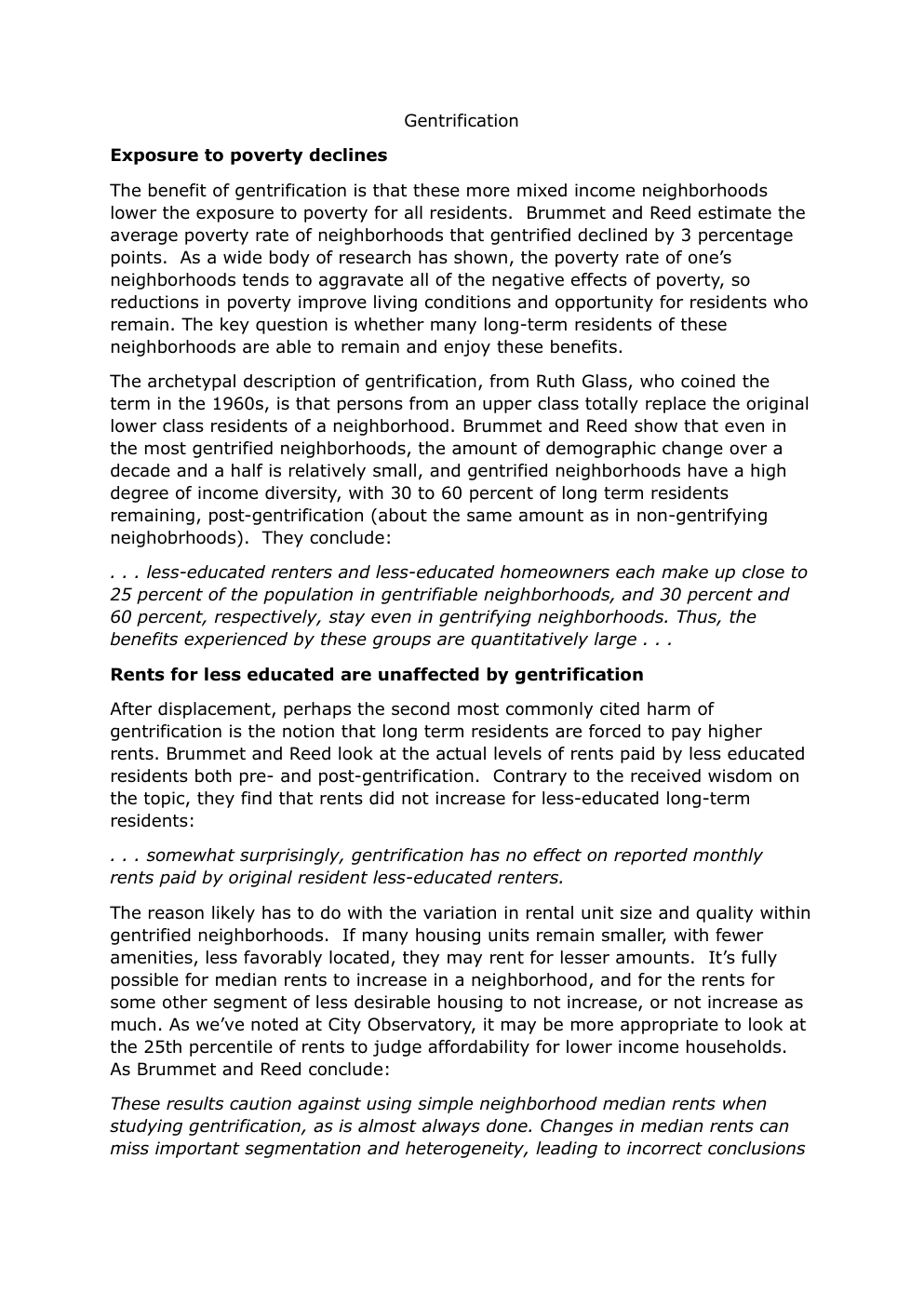Gentrification
Publié le 30/04/2025
Extrait du document
«
Gentrification
Exposure to poverty declines
The benefit of gentrification is that these more mixed income neighborhoods
lower the exposure to poverty for all residents.
Brummet and Reed estimate the
average poverty rate of neighborhoods that gentrified declined by 3 percentage
points.
As a wide body of research has shown, the poverty rate of one’s
neighborhoods tends to aggravate all of the negative effects of poverty, so
reductions in poverty improve living conditions and opportunity for residents who
remain.
The key question is whether many long-term residents of these
neighborhoods are able to remain and enjoy these benefits.
The archetypal description of gentrification, from Ruth Glass, who coined the
term in the 1960s, is that persons from an upper class totally replace the original
lower class residents of a neighborhood.
Brummet and Reed show that even in
the most gentrified neighborhoods, the amount of demographic change over a
decade and a half is relatively small, and gentrified neighborhoods have a high
degree of income diversity, with 30 to 60 percent of long term residents
remaining, post-gentrification (about the same amount as in non-gentrifying
neighobrhoods).
They conclude:
.
.
.
less-educated renters and less-educated homeowners each make up close to
25 percent of the population in gentrifiable neighborhoods, and 30 percent and
60 percent, respectively, stay even in gentrifying neighborhoods.
Thus, the
benefits experienced by these groups are quantitatively large .
.
.
Rents for less educated are unaffected by gentrification
After displacement, perhaps the second most commonly cited harm of
gentrification is the notion that long term residents are forced to pay higher
rents.
Brummet and Reed look at the actual levels of rents paid by less educated
residents both pre- and post-gentrification.
Contrary to the received wisdom on
the topic, they find that rents did not increase for less-educated long-term
residents:
.
.
.
somewhat surprisingly, gentrification has no effect on reported monthly
rents paid by original resident less-educated renters.
The reason likely has to do with the variation in rental unit size and quality within
gentrified neighborhoods.
If many housing units remain smaller, with fewer
amenities, less favorably located, they may rent for lesser amounts.
It’s fully
possible for median rents to increase in a neighborhood, and for the rents for
some other segment of less desirable housing to not increase, or not increase as
much.
As we’ve noted at City Observatory, it may be more appropriate to look at
the 25th percentile of rents to judge affordability for lower income households.
As Brummet and Reed conclude:
These results caution against using simple neighborhood median rents when
studying gentrification, as is almost always done.
Changes in median rents can
miss important segmentation and heterogeneity, leading to incorrect conclusions
about how the housing costs paid by different types of households are actually
affected.
The dynamics of neighborhood change
Implicitly, much of the discussion of gentrification takes a highly static view of
neighborhoods.
It assumes, that somehow, in the absence of gentrification, and
neighborhood will somehow stay just as it is.
As Brummet and Reed show, all
neighborhoods, including both gentrifying and non-gentrifying lower income
neighborhoods, experience substantial turnover in population over the course of
a decade or so.
Neighborhoods are always changing, and the low income neighborhoods that
don’t gentrify don’t somehow stay the same: they lose population, and
experience declines in income.
The average low income neighborhood that didn’t
gentrify between 2000 and 2012 lost 8 percent of its population, and saw a
decline in average incomes of 21 percent (Tables 4 and A5).
Also: change in
gentrifying neighborhoods is not a zero sum game, with each new resident
replacing, one-for-one, a previous resident: Gentrifying neighborhoods saw their
total population increase 21 percent.
These results parallel closely the findings
from City Observatory’s own Lost in Place study of neighborhood change from
1970 to 2010 that showed that high poverty neighborhoods that didn’t gentrify
lost 40 percent of their population over four decades, while gentrifying
neighborhoods recorded increases in population.
This underscores why adding
new housing in gentrifying neighborhoods can be an important ingredient in
assuring they remain diverse and equitable.
Are these results really surprising?
While the Detroit Free Press labeled these results “surprising”, — “Study reveals
surprising results about Detroit gentrification,” — they actually fit the pattern of a
growing body of careful studies of neighborhood change.
Martin and Beck found
that there was almost no difference in out-migration between gentrifying and
non-gentrifying poor neighborhoods.
Ingrid Gould Ellen and her colleagues,
using data on kids born to families receiving Medicaid benefits showed virtually
no displacement due to gentrification, and also showed that residents who
moved generally relocated to similar neighborhoods.
Lance Freeman‘s work has
shown that displacement rare, Jacob Vigdor has shown that long-time residents
are somewhat more likely to stay in gentrifying neighborhoods than nongentrifying ones.
There’s a decided “man-bites-dog” character to media reporting on this paper.
The Detroit Free Press summarizes the findings as “challenging the notion than
gentrification is as harmful as many believe.” The Philadelphia Inquirer headlined
its story, “Effects of gentrification on long time residents are not as negative as
typically perceived, Philly Fed study says.” CityLab talks about the “Hidden
Winners” from gentrification; apparently, gentrification is so widely known to be
A BAD THING, that it’s....
»
↓↓↓ APERÇU DU DOCUMENT ↓↓↓


